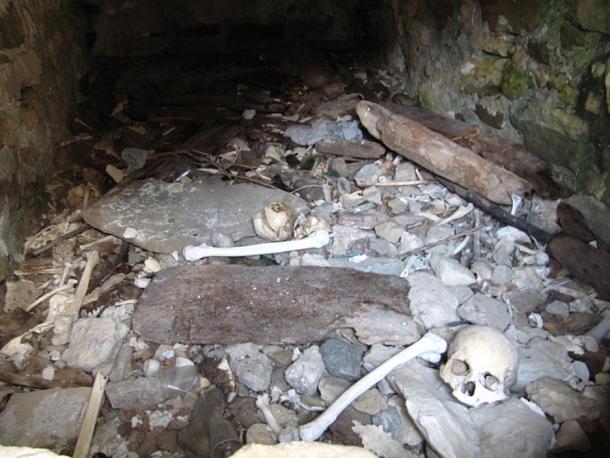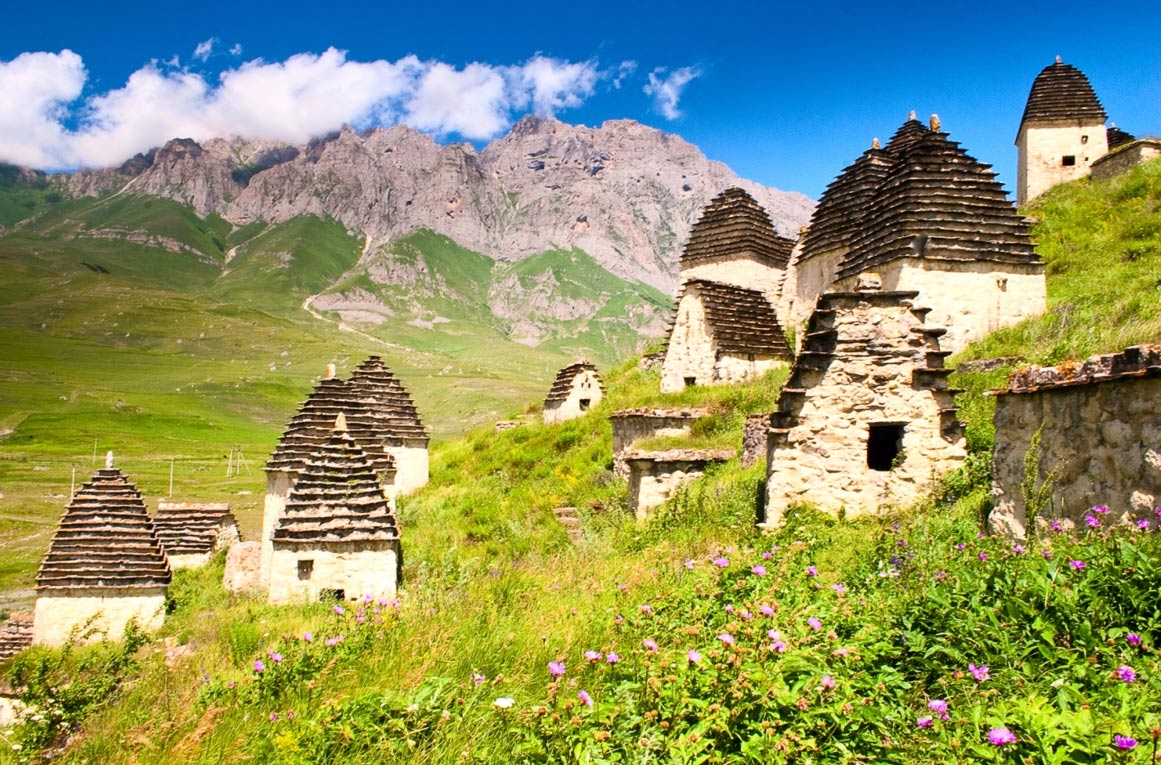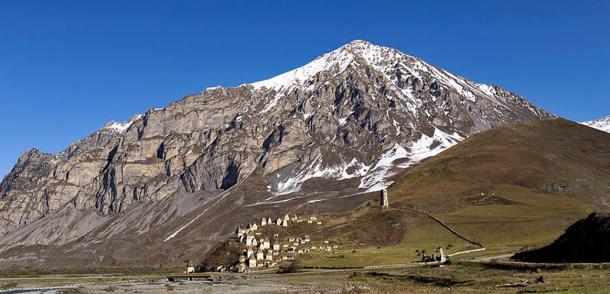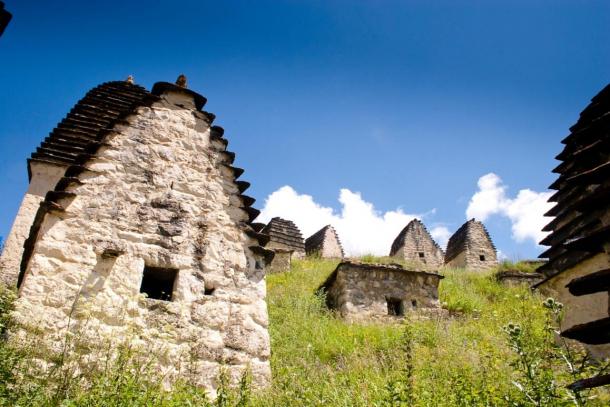
Skeletons inside Dargavs Crypt, Russia
Often referred to as the City of the Dead , the village of Dargavs is considered to be one of the more mysterious sites in Russia. Hidden away in one of the five mountain ridges somewhere in the Caucasus mountains, the “city” is actually an ancient necropolis full of tombs or crypts. The people who lived here, buried their loved ones in this site for reasons that have been lost in the passage of time.

Many myths and legends surround the site and in the past local people refused to go here out of fear that they would not come out alive. Some sources say the oldest crypts dates back to the 16th century and were made due to a plague that swept through the area decimating the population.
The Remote Location of the City of the Dead
Dargavs is located in the republic of North Ossetia in southern Russia. A three hour drive through dangerous and winding roads, the site sits on the slope of a hill overlooking the Fiagdon River. It lies in the middle of a mountain valley which stretches over 17 kilometers (10. 6 miles) with 4,000 meter (13,000 feet) peaks looming above the village.

Mountain looming over Dargavs: The City of the Dead
The first mention of the site dates back to the beginning of the 14th Century AD, when the ancestors of the modern day Ossetians settled down on the mountain ridge. Since the land was so expensive, it is said they were forced to choose the windiest and most unserviceable place imaginable. However, at one time this area was also the center of the largest population in Eastern Ossetia.
The necropolis looks like the remains of a medieval village, with small dwellings grouped together on a grassy hill. But go closer, and you won’t find a living soul inside any of these houses. That’s because residents have been burying their dead here for hundreds of years and in each crypt human skulls and bones have been found.
The Architecture of the Dargavs Crypts
The grassy hill that Dargavs is located on is dotted with little white buildings. These white, house-like structures, are stone crypts and the necropolis has almost 100 of them that rise up the hillside in a very organized manner. At the back of the entire complex is a watch tower whose top part has been destroyed. It is said that the tower was placed there to watch over the resting souls. The tombs themselves are shaped like huts with curved roofs going inwards in steps and pointed peaks at the top, typical of Nakh architecture.
Some of the bigger crypts are 2 to 4 stories high and the smaller crypts have flat sides on the front; several crypts have no roofs at all. On the inside of the larger crypts there is a pyramidal groin vault complex that holds up the roof. The smaller crypts have pointed barrel vaults. These pyramidal and conical roof vaults are built of slate in the form of stepped ledges. The walls are made up of stone blocks and mortared (most likely with lime or clay-lime) and have square, window-like openings which were designed to put corpses inside.
The people who lived in the valley buried their loved ones along with clothes and other belongings. Each family had a crypt, and the taller the tomb, the greater the number of people who were buried inside. Some have underground chambers while others have two and even three floors depending on the number of generations of family they hold. There are also common crypts, which were used for those who had no family or were from outside the village.

Close-up image of building, ruins of settlement, Dargavs, Russia (Bigstockphoto)
Legends and the Mysterious Dead Boatmen and Women
Interestingly, it was discovered that the bodies inside the crypts were buried in wooden structures resembling boats (one was even found with an oar next to it). The mystery remains as to how and why the boats came to be there when there are no navigable rivers nearby. One explanation is that it was believed that the departed soul had to cross a river in order to get to heaven, similar to the afterlife stories of ancient Egypt and Mesopotamia. Another interesting fact is that there are wells in front of each crypt. Many coins have been found in the ground near the complex and it is said that when the Ossetians buried their dead, they dropped a coin in the well. If it happened to hit a stone at the bottom, that meant that the soul of the dead had reached heaven.
One legend that surrounds the cemetery says that any man who dared walk in would never come out alive again. This is said to be the reason locals almost never visit Dargavs. Another legend says that the site is where a group of warriors kidnapped a beautiful girl from a faraway land. Since they could not agree on who owned her, they killed her. The gods punished the highlanders for murder and they slowly died from a strange disease in the tombs.
Conversely, most historians believe that a great plague hit the area of Ossetia sometime between the 16th and 18th century AD; one which claimed tens of thousands of lives and dropped the Ossetian population from 200,000 at the end of the 18th century to 16,000 by the middle of 19th century. In order not to infect their neighbors, the sick, with whole families and children, went into these pre-built crypts and never came out again. They survived on meager rations of food brought in by locals and their corpses were left to rot inside the huts when they died.
Dargavs Today - a Ghost town
There are several similar “Cities of the Dead” scattered across Ossetia, but Dargavs is considered to be the most impressive probably due to the large number of mausoleums here and the stunning natural beauty of the area.
During Soviet times, tourists came to visit by the busload, and there was even a ticket booth manned by an Ossetian babushka (Russian grandmother). The environment of Dargavs is rich in monuments from the Bronze Age to the late Middle Ages and has provided archaeologists with a wealth of information about how Ossetians in the area lived hundreds of years ago.
Despite the archaeological richness, the mystery, and the beauty of the site, these days it has all but been deserted. Rarely do tourists visit this place - which is like to be due more to the difficulty in getting to Dargavs than any death curse associated with it.

Facebook Comments